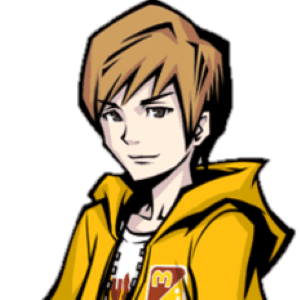The lore of League of Legends is… a complicated mess when viewed generously. Runeterra being an IP whose story used to be a thinly-veiled explanation for its related Multiplayer Online Battle Arena has been reworked at least twice, and in some ways it’s not hard to see why. Not only was League’s world bloated by a huge number of disparate archetypes vying for attention, but the stories told about the world rarely got to go anywhere since MOBAs are competitive games where usually nothing changes and all is non-canon. Over time the writers on the Runeterra brand have done their absolute best to stitch together something vaguely coherent from the flippant early days, but even these efforts are often met with contradiction and friction of intent. It is against this backdrop that the Riot Forge project was born, a collaborative effort between Runeterra’s parent company and various third-party developers to make single-player experiences with the breathing room to tell the stories that desperately needed expanding upon. Today’s title isn’t the first one released under this initiative and it won’t be the last, but I’ve chosen to review it because of how it touches on the places and characters most dear to me as a former League player and current Legends of Runeterra enthusiast. This was definitely a game I had strongly mixed emotions about going into, but where are my emotions now that I’ve seen it through?
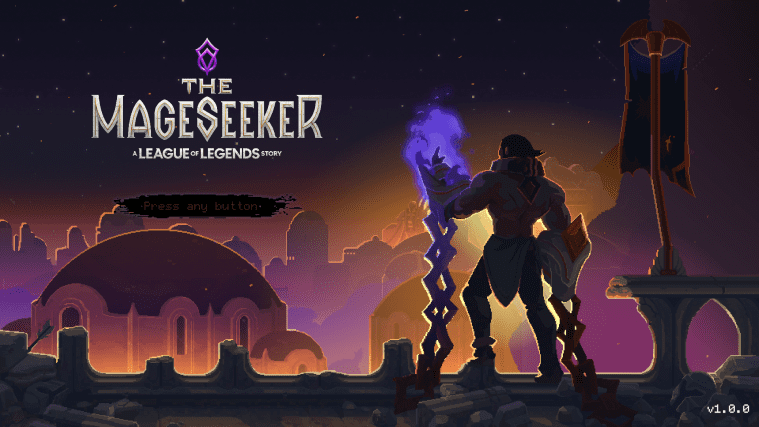
Developed by Digital Sun, published by Riot Forge, and released on April 18th 2023, The Mageseeker: A League of Legends Story is an action-combat angry sewer man simulator for PC, PS4, PS5, Xbox Series X, and Nintendo Switch. Its premise involves an escaped convict joining a band of magical revolutionaries as he fights the organization responsible for his imprisonment. Players interact with the game by traversing levels, discovering treasures, fighting enemies, upgrading at a home base, and plenty of reading material. Note that I played the PC version for this review, and that your experiences might change depending on the platform.
The story of The Mageseeker takes place in the kingdom of Demacia and follows Sylas of Dregeborne. Sylas was once a part of the Order of the Mageseekers when he was young, tasked with discovering hidden mages among the populace. An accident involving some insubordination led Sylas to be convicted of murder and imprisoned for fifteen years. The game picks up shortly after Sylas escaped his prison and attempted regicide in the Lux comic (he tried to kill the king, but the king was already mysteriously killed by an unknown assassin so he went after the prince), fleeing the Great City of Demacia with other escaped mages as the city burns. From there he becomes not-so-loosely aligned with a band of rebels hiding in the nearby forests and sets out on a quest to enact vengeance against the Mageseeker Order.
… Ok buckle up people because I have ground to cover. Long tangent-not-tangent begins now.
Going into this game, the fact that it follows a character who is blatantly a villain raised some serious red flags for me, and the fact that it was Sylas in particular more so. His introduction into the Demacia storyline was representative of a larger effort by the writers at Riot Games to make Runeterra more morally ambiguous (my theory is that they did this so that players could have an easier time imagining their favorite characters as “heroes” regardless of their actual morality). When they added him and all of his surrounding lore elements to their game(s) however, the results were VERY mixed with fans. On one hand you had fans who were totally on board with the introduction of the mage persecution plotline and liked having the freedom to dunk on Demacia as much as possible. On the other hand you have Demacia fans like me who, aside from realizing that the obvious allegories present did not at all communicate what the writers wanted if you really break it down, were rightly frustrated by how this sudden development recontextualized an entire legacy of beloved characters to be ignorant at best and hypocrites at worst. And from then on the lore surrounding Demacia just kind of sat in this weird 4-year limbo where nobody could agree on how to feel about all of it.
To say that making this divisive character the protagonist of a whole game was a bold move is an understatement. Personally, as much as I wanted the mage civil war to be addressed properly, I also dearly wished it could be from the point of view of someone with a more balanced view of things like Lux. But thankfully after giving the game a shot, they do manage to focus the blame for the ills of mage suppression on the Mageseekers and not broadly blaming Demacians as a whole for their misdeeds (although you may not notice this if you only listen to what Sylas has to say about it), and the legacy characters come out of the stories back as their iconic selves that we know and love, I daresay even more virtuous and lovable for having grown as people during this story. The only exception to this would be the portrayal of Morgana and by consequence Kayle, who have been completely twisted and subverted in their retcons to the point of absurdity, on top of being the focal point of the Runeterra writers’ false dichotomy between justice and mercy. It’s actually impressive how arguably satanic the symbolism surrounding Morgana is and I could have a field day breaking it and everything else Demacia down for you, but I best move along both for the sake of spoilers and my own sanity. But yeah, in summary the bits of lore which felt forced upon Demacia in a meta sense turned out to be the in-universe source of conflict all along too, shocking I know.
Tangent-not-tangent over, thank you for your attention!
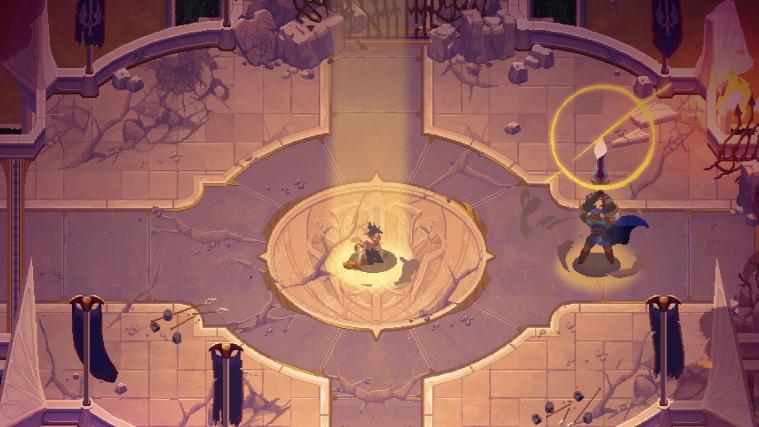
Regarding the story of The Mageseeker from a more self-contained perspective it’s… fine. While the story isn’t bad or anything, it plays its premise surprisingly safe and doesn’t really ask much of the audience. Plot twists are mostly predictable, and you have probably met every character in the main cast somewhere else in another tale, by another name. The main thing that holds the story back for me is Sylas, as from the beginning of the story to the end he remains the same bitter man throughout, with his only real development being that he finds an in-group that he comes to care about. Characters like Sylas who have little heroic virtue, or hold twisted versions of said virtues, have equally little to teach us unless they are thoroughly shown to suffer for their iniquity as a cautionary tale, and The Makeseeker unfortunately is not one of them. I kinda feel the story assumes everyone sees revenge as a relatable motivator, and expected me to be more on board with Sylas’ mindset than I actually was (and the game kinda tries to call him out on his vengefulness but I really didn’t feel it did a great job in this regard, especially considering the goal he begins to pursue in the game’s epilogue). The story certainly made me feel things, but maybe more towards characters and events that I was previously invested in rather than the new things it had to show.
As for the gameplay, The Mageseeker is best described as a level-based action game where you enter into linear areas to play out a piece of the story while battling off enemies and doing some light secret hunting in small alternate paths. In combat you have your standard action game staples of light and heavy attack combos, an invincible dash, and a grappling hook maneuver. What really separates this title for the many others like is the spell-stealing system. Any magically-inclined enemy you fight will have an associated spell that you can copy and use against the enemies. Furthermore these spells have elemental affinities with three opposing pairs, meaning enemies are resistant to damage from their own element type but take extra damage from the opposing type (fire and ice for instance). Not only does this mechanic allow you to play with a wide range of abilities over the course of each combat encounter, it creates a naturally engaging dynamic where you want to defeat enemies efficiently but also want them active so you can steal their spell to use against another enemy of opposite alignment. It’s the process of analyzing the enemy formation and discerning how to take advantage of their powers where the depth of the game really shines. Do I leave these enemies alive a little longer to use their spells, or do I take them out so I have to avoid fewer attacks? Aiming your chains to execute on these steals has a bit of a learning curve, but the game is surprisingly intuitive once you learn the basic strategies available. Even if you are overwhelmed by the game though, The Mageseeker lets you manually adjust the damage Sylas receives and takes as well as the enemies, so it’s much more accessible than you might think.
With all that said there is one issue that needs to be addressed now so that there are no false expectations: the launch version of the game is rather buggy. Once or twice I ran into an enemy that couldn’t take damage and had to run past it, and there was an enemy that slipped out of the boundary which I had to back away from so it would walk back in. But then there’s the issues which assailed me more frequently, like how viewing long lore entries from the menu simply does not work when using a gamepad since the scroll bar doesn’t read your right-stick inputs, and most of all the bug where my attack buttons would straight up stop working and I could only reset it by performing a grapple. I had found it odd that the game was released so close to its own announcement date (albeit it had been teased for longer), but this day one build really feels unpolished. Maybe in the future if these issues were fixed I could say this game’s gameplay is top notch, but for now it’s a little held back.
As for the remainder of The Mageseeker’s systems, they’re all pretty simple. Exploration in the levels usually doesn’t add up to much more than going the opposite way from the story and finding a resources chest, but on occasion these will be guarded by bonus enemy encounters so it’s engaging enough. Also exploration will net you some baby silverwings who will nest at your home base, and silverwings are the best Runeterra pet so I liked collecting those little guys. Said home base features a variety of stations to upgrade Sylas’ abilities, and gets bigger and more lively as you recruit more mages to your cause. Most of these upgrades are essentially just power-gating your damage and defense, and there’s more than enough resources to get all of them before the final level so unfortunately it’s hard to feel like you’re making meaningful build paths. What systems are good though are the stored spells and the elite outlaws. Stored spells allow you to purchase a permanent copy of any normal enemy’s spell to cast at any time during battle provided you’ve generated enough mana through melee combos. The elite outlaws are essentially partners who you can send on assignments for rewards, but more importantly are brought along on missions to provide new combo routes featuring elemental damage and generally boosting the power of their specialty element.
These systems are great because of how they give the player decisions to make before starting missions. Before each level you are shown the types of enemies which are most common in that level, and adjusting your four stored spells and two elite outlaws can mean a lot as to whether a stage is easier or harder. This becomes particularly apparent later in the game when levels heavily feature one element but not its counterpart, basically demanding that you pay attention and change your loadout to defeat these enemies more quickly. On normal mode the game is easy enough that you can brute force a single build by the end of it if you want to (I went for an ice and lightning build since their bonus combos are easy to pull off), but I imagine that preparation like this is key on higher difficulties. On the whole, while the systems surrounding the core combat aren’t the most interesting, there is depth to be found in the player customization which makes it worth experimenting with, at least until you find something that works for you.
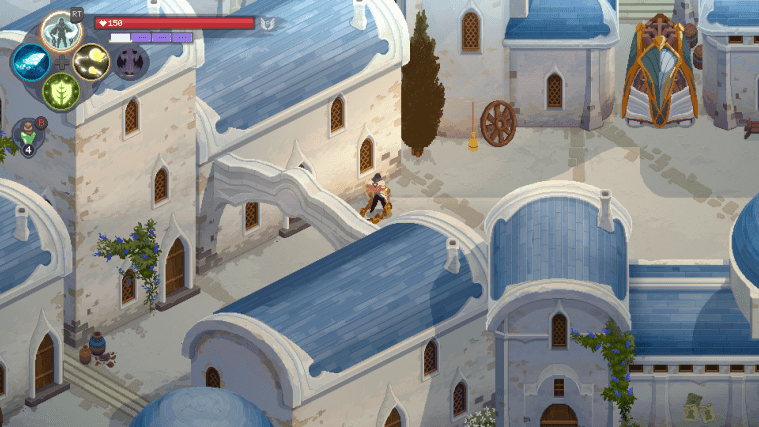
Presentation wise, The Mageseeker is a gorgeous pixel art game. Character animations are smooth and expressive, particle effects are dramatic and wonderful, and the environment design is just perfect. Even despite Sylas’ constant disdain for the world around him, it was an absolute dream experience to walk the beautiful streets of Demacia’s towns and cities for the first time, and the forests are rich with beautiful landmarks and a heavy atmosphere. The game does reuse assets frequently and even runs through old locations during its latter levels, but personally I was too busy taking in the sights to really care. I only wish the music could have elevated the environment more. The somber violins which permeate the soundtrack certainly set the mood but I can’t say I’ll be remembering any of them a few days from now. The organ pieces are fun, but those are really my only highlights from the score.
Lastly, as far as moral wisdom which a Catholic or really anyone might find reflected in the game, to be honest it can be pretty difficult to find that many examples when playing the villain’s role. Freeing the wrongly imprisoned is one thing, but promptly encouraging revolution and bloodlust in those prisoners is another thing entirely, ya know? And of course don’t get me started on everything to do with The Veiled Lady. However, I think we can all see a little bit of our struggles in pursuit of justice through the three principle champions who broadly represent each side of this story: Sylas, King Jarvan Lightshield IV, and Luxanna Crowngard. Despite being the protagonist of the game Sylas shows us how ugly justice predicated on sheer vengeance and hate really is, in the way he treats both his enemies and his allies. He may have a justified reason to take the side he does and was deprived of any hope of a good role model in his youth, but he failed to rise above himself nonetheless and his vengeful heart plagues his every action. In Jarvan IV we see more promise to pursue justice against his father’s killer, but he too falls far into his own despair and relies unthinkingly on Lord Eldred’s council instead of critically considering what the true path of justice is. Lastly with Lux we see a true understanding of the path towards the future and the clearest vision of what’s right, yet even she falters in seeking to place the burden of justice all on herself instead of building a community that can truly pursue what is right in concert.
From these three combined we can see more clearly the shape of the true justice that all men strive for. To focus on what each person is truly due rather than on what will subjectively satisfy our warped inclinations, being mindful of whether the voice that sounds most reasonable to our flawed perspective is genuine or manipulative, and to accept the perspective, wisdom, and strength of those around us to pursue it more perfectly. The task of recognizing where and how to best enact justice is a difficult task, especially considering classical virtue ethics like those of Aristotle and St. Thomas Aquinas suggests that it is only fully attainable when the other cardinal virtues of prudence (sound judgments for human flourishing), fortitude, courage (especially of the moral kind), and temperance (which in this case relates heavily to mercy) are also present. But this should not be an occasion for despair at the gravity of this task, for through our bonds with the people most important to us and especially to the Lord God we can help one another come to attain these virtues, and ultimately guide lives down the best path possible. All of the best characters in this story find their way again by letting the best in those they love remind them of justice’s true form, and oh how much more so does that apply to us in the real world. Especially we who strive to commune with Justice Himself.
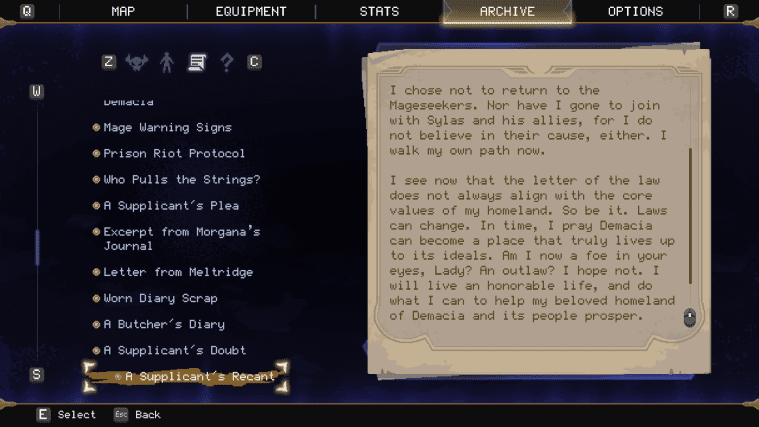
In conclusion, The Mageseeker turned out to be a fairly fun action game to my relief. Its plethora of suspect symbolisms and errors of modern intellectual thought does limit the actual scope of people I would recommend this game to quite a bit, perhaps to the point that it really should only be played by those familiar with the source material and who need those narrative gaps filled. If you fall into this very specific category however, it’s an entertaining romp through one of gaming’s most iconic fantasy kingdoms (and our first real tour of it no less!), along with having a genuinely fun gameplay loop that’s way more challenging and in-depth than it looks. The road to closing off this story has been long and turbulent indeed, but hopefully with the tale of Sylas the Unshackled finally brought to a proper conclusion, it will be all up from here for Demacia.
Score: 76%
Gameplay: 4/5
Story: 3/5
Art and Graphics: 5/5
Music: 3/5
Replayability: 4/5
Morality/Parental Warnings
The Makeseeker: A League of Legends Story is a game told from the perspective of a vengeful criminal with unmatched revolutionary spirit. He derides his enemies with spiteful words, recruits allies to his cause by inspiring a want of bloodlust, and even enlists youths into his dark service. His immediate allies share his sentiments to varying degrees. The game also features magic as your primary means of fighting as well as being the major aspect tying the cast together. While the magic in and of itself is just described as a sort of primordial force certain people can tap into, it’s also not lost on me that the protagonist edits his loadouts at shrines to the fallen angel Morgana. Morgana herself is a particularly concerning character, and she represents a false dichotomy between mercy and justice with her championing the mercy side, is entirely depicted as a source of boons and truth to the kingdom, and yet is wholly luciferian in her aesthetics. There are no literally demonic images in the game, but she does affect the game’s symbolism such that light is often cast as evil and darkness good, especially at the final boss. There are references to ‘demons’ in the lore of the game too, however it only really affects one side story. Themes of human experimentation are also present in the game, as you do explore some decently graphic Mageseeker laboratory environments. The Mageseeker Order commits plenty of other crimes against humanity too.
Combat involves battles against humans, monsters, and constructs, relying heavily on magic attacks, but blood is either rare or outright censored in other colors. Character design is actually pretty modest throughout The Mageseeker’s cast, although you’d be forgiven for thinking otherwise since they refuse to put a shirt on Sylas. Gideon’s main motivation is to reunite with his “husband”. Foul language is not uncommon in the game’s script. There is reference to a charitable organization called The Illuminators in the collectible reading materials which plays the part of some kind of weird humanist religion, as they describe themselves as preachers yet declare “have not faith, but ideals”. The game also confuses the concepts of ‘magic’ and ‘miracles’ during one cutscene, though I suspect this may have been an intentional subversion.
Head on over to our Patreon page if you want to support our articles and gain exclusive rewards. Thank you so much for reading!
